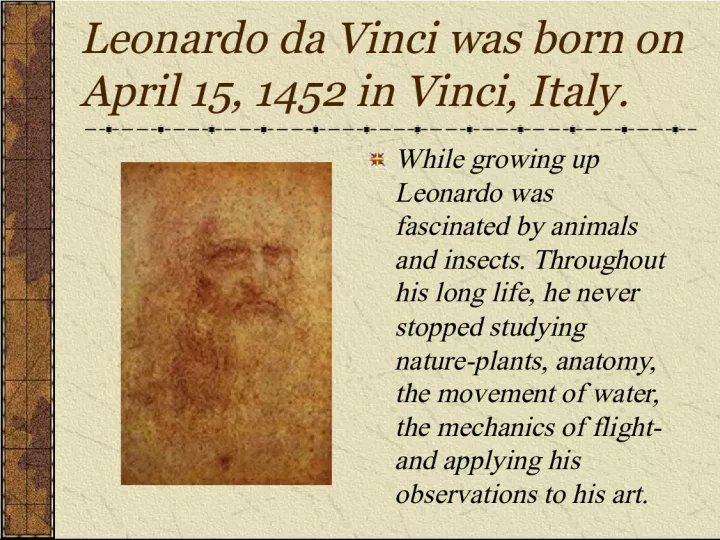The Multifaceted Genius: A Look into Leonardo da Vinci's Life


This article explores the life of Leonardo da Vinci, one of the most well-known polymaths in history. From his early fascination with animals and insects to
- Uploaded on | 1 Views
-
 angela
angela
About The Multifaceted Genius: A Look into Leonardo da Vinci's Life
PowerPoint presentation about 'The Multifaceted Genius: A Look into Leonardo da Vinci's Life'. This presentation describes the topic on This article explores the life of Leonardo da Vinci, one of the most well-known polymaths in history. From his early fascination with animals and insects to. The key topics included in this slideshow are . Download this presentation absolutely free.
Presentation Transcript
Slide2Leonardo da Vinci was born onApril 15, 1452 in Vinci, Italy. While growing up Leonardo was fascinated by animals and insects. Throughout his long life, he never stopped studying nature-plants, anatomy, the movement of water, the mechanics of flight- and applying his observations to his art.
Slide3An Artist and a ScientistBecause Leonardo the artist sought for the ideal face, he skillfully sliced open the skull to reveal the brain cavity and see what lay beneath. Combining art and science he analyzed the proportions of the head.
Slide4 “ We shall describe this mechanical structure of man by means of diagrams” Leonardo raised the study of the “structure of man” to a science. He sought to illustrate the inner structure of man. His drawings were so accurate that they are still used to illustrate anatomy texts today.
Slide5Animal StudiesLeonardo was often impatient with men, but he had a special fondness for animals. His lively sketches of cats are drawn with great affection. Look carefully for the cat that became a dragon.
Slide6At first Leonardointended to learn about the human body so that he could paint it more realistically. But soon he began to hope that it would bring him to the answer to the riddle of creation. Man and God
Slide7AnatomicalStudy Leonardo often watched doctors perform autopsies so that he could study human anatomy. He later began dissections on his own and carefully sketched everything that he saw.
Slide8The InventorLeonardo modeled his flying machines after his studies of bird wings. And though he failed at actually taking air, his careful and inventive researches in aerodynamics made him a forerunner of modern flight.
Slide9Mona LisaLeonardo Da Vinci painted the Mona Lisa on a piece of pine wood in the year 1506. Never in the history of Art has one painting been so admired. This is due largely to the enigmatic smile, which has caused much speculation.
Slide10The Last SupperConsidered by many to be Leonardo’s greatest painting, The Last Supper employs all of his anatomical work in the expressions of Christ and the Apostles.
Slide11The CodesLeonardo wrote in Italian using a special kind of shorthand that he invented himself. People who study his notebooks have long been puzzled by something else, however. He usually used "mirror writing," starting at the right side of the page and moving to the left. Only when he was writing something intended for other people did he write in the normal direction.
Slide12An Artistic and Scientific Search for theTrue Picture of Man and his Universe "Leonardo da Vinci was like a man who awoke too early in the darkness, while the others were all still asleep" -Sigmund Freud